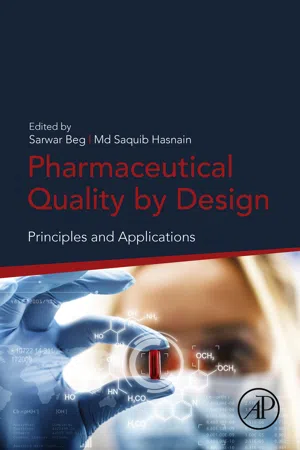Technology & Engineering
Quality by Design
Quality by Design (QbD) is a systematic approach to product development that focuses on designing quality into the product from the outset. It involves identifying critical quality attributes, understanding and controlling the manufacturing process, and using risk management to ensure consistent quality. QbD aims to enhance product quality, reduce variability, and minimize the need for post-production testing and corrective actions.
Written by Perlego with AI-assistance
Related key terms
8 Key excerpts on "Quality by Design"
- eBook - ePub
Cost-Contained Regulatory Compliance
For the Pharmaceutical, Biologics, and Medical Device Industries
- Sandy Weinberg(Author)
- 2011(Publication Date)
- Wiley(Publisher)
Secondly, QbD is logically consistent. It provides a rational framework for controlling quality in production, search, laboratories, and other requirements, with a reasonable and defensible system of tolerances and permissible variants. QbD makes good sense for the management of an automated laboratory: Understand the processes involved, measure the performance of those processes, and interpret those measurements in a risk construct.With reasonable assurance, a QbD approach to laboratory quality control and assurance will be the dominant paradigm of the future. 4.10 SUMMARYQuality by Design (QbD) is an evolving initiative of the US Food and Drug Administration, simplified from more extensive and rigorous methodologies of the same name in use in the general manufacturing engineering industries. In its current configuration, QbD includes (a) the use of a Risk Assessment to determine which variables and parameters are most important in the quality control of a product, (b) the use of a Design Space analysis to determine the effective range or variance of those variables, and (c) the use of a Process Analytical Technology approach to continuously monitor and cyberneticly adjust those variables. Once implemented, QbD can greatly improve quality assurance and control while containing costs; the investment necessary to cd xposition a system for QbD varies widely. It is likely to represent a cost increase (with reasonable payback period) until regulatory guidelines and/or industry standards force that investment.Quality by Design is therefore likely to represent a short-term cost increase but a long-term effective cost containment strategy, and it is likely to be a mandatory norm within the next two to five years.Notes1 Kamm, J. Can You Win the Space Race? Pharmaceutical Manufacturing, May 2007.2 Weinberg, S. Early Warning: Attitude Adjustment at FDA, American Biotechnology Laboratory, July 2003.3 - (Author)
- 2020(Publication Date)
- Academic Press(Publisher)
Chapter 1Quality by Design as an emerging concept in the development of pharmaceuticals
Dnyaneshwar Kalyane1 , Nidhi Raval1 , Suryanarayana Polaka1 and Rakesh K. Tekade1 , 2 ,1 1National Institute of Pharmaceutical Education and Research-Ahmedabad (NIPER-A), An Institute of National Importance, Government of India, Department of Pharmaceuticals, Ministry of Chemicals and Fertilizers, Palaj, Gandhinagar, Gujarat, India,2 2Department of Materials Engineering, Indian Institute of Technology (IIT) -Jammu, Jagti, Jammu, IndiaAbstract
Recently, Quality by Design (QbD) approach is widely being used in the field of pharmaceuticals due to their several advantages. This approach gives a better process and product understanding before its development, which ultimately helps in the development of a better-quality product. Nowadays, there are several new drug applications and abbreviated new drug applications filings observed in the field of pharmaceutical product development, biotechnological product development as well as for the development of new chemical entities by employing the QbD approach. This chapter focuses on the emergence of QbD as a quality tool as well as in detail involved steps within it. Moreover, this chapter also looks at applications of QbD in different fields. Last, this chapter also gives information about regulatory guidelines and hurdles in the implementation of QbD.Keywords
Quality by Design; new drug application; ICH Q8; quality risk management; failure mode effect analysis1.1 Introduction
The quality of a pharmaceutical product has a direct connection with the safety and efficacy of the product. The poor-quality end product can deliberate the harmful effect on the patient as well as it may not achieve the intended therapeutic threshold leads to poor therapeutic efficacy. For this, developing a quality product and maintaining its quality is of the utmost importance (Raval et al., 2019 , Raval et al., 2020 ). Currently, many pharmaceutical industries use the conventional approach for the development of quality products (Raval et al., 2018 , Advankar et al., 2019 ). The conventional approach includes the sequential testing of raw materials, product manufacturing process, and finished product testing (Acharya et al., 2018 , Amarji et al., 2018 ). This approach is also known as quality by testing. But, this approach possesses few limitations like it increases the cost of experiments, takes longer time, and if the final product fails FDA specifications then the product development process needs to start from the first step (Devadasu et al., 2018 , Soni et al., 2018 , Kapoor et al., 2020- eBook - ePub
Quality in the Era of Industry 4.0
Integrating Tradition and Innovation in the Age of Data and AI
- Kai Yang(Author)
- 2023(Publication Date)
- Wiley(Publisher)
Design Quality: This denotes the value that a design offers to customers. As the output of design spans products, services, and user experiences, design quality or the quality of the design corresponds to the degree of excellence or value of these outputs. Design is the origin of all qualities, extending to the quality of products, services, and experiences. Design quality encapsulates all dimensions of quality including functionality, usability, reliability, performance, safety, esthetics, and more. Factors such as customer satisfaction, brand perception, sales volume, market share, reliability, and performance often serve as metrics to assess design quality.- Quality by Design: This term signifies a dedicated approach to product development and manufacturing that emphasizes embedding quality at each stage, with a particular focus on the initial stages of the product life cycle. Quality by Design incorporates innovation and QA into the design and development process instead of relying on quality control in manufacturing and post‐production inspections and rectifications.
The role of design in the product life cycle has been underscored by scholars across disciplines like innovation/R&D management, operations management, and marketing management. There is substantial agreement across these fields on the substantial contribution of design to the competitive performance of a product and a company [3 , 33 , 34 ]. The field of quality management and quality engineering is also witnessing a growing recognition of “Quality by Design” as an effective and significant approach to achieve superior quality. The success stories of Apple Inc. and Samsung offer prime examples of this.A pressing question in the current scenario, as we transition into the era of Industry 4.0, is how will we implement “Quality by Design”? Before delving into this, let us first understand the changes brought about by Industry 4.0.3.4.2 Some Significant Changes in Business Ecosystem in Digital Revolution
Just as humans and animals exist within ecosystems in nature, businesses operate within their own ecosystems. A business ecosystem comprises a multifaceted network of individuals, organizations, and technologies, all interconnecting to create, deliver, and capture value. It encapsulates every actor involved in the conception and provision of a specific product or service, as well as the supporting technologies and infrastructure. While the constituents of a business ecosystem vary depending on the specific industry and market, they typically include the following: - Jelena Duris(Author)
- 2013(Publication Date)
- Woodhead Publishing(Publisher)
1Quality-by-design in pharmaceutical development
Jelena Djuris, Svetlana Ibric and Zorica Djuric, Department of Pharmaceutical Technology and Cosmetology Faculty of Pharmacy University of BelgradeAbstract:
This first chapter introduces the concept of quality-by-design (QbD) and its role in pharmaceutical product development. QbD assures the quality of a pharmaceutical product through scientific development and risk management tools, and will eventually enable real-time release, regardless of the formulation type. Several guidelines on pharmaceutical development, quality risk management, and pharmaceutical quality systems are presented that are applicable throughout the product lifecycle. Design space appointment and control strategies for risk management are introduced. The meaning of the QbD concept is presented from both regulatory and manufacturers’ points of view. Several illustrative examples are provided to facilitate the understanding of the QbD concept and ease of its application.Key words quality-by-design (QbD) design space risk management tools control strategies1.1 Introduction
The pharmaceutical industry is one of the most strictly regulated and its products are of excellent quality. However, there are issues suggesting that pharmaceutical development and manufacturing can be improved. These facts are especially noticeable in cases of batch failures and reworks, regulatory issues, implementation of new technologies, etc. The current state of the pharmaceutical industry, in terms of yield and defects (e.g. relation of quality and productivity), is not comparable to some of the more advanced industries (e.g. the semiconductor industry). Defects in pharmaceutical product quality can be encountered such as low manufacturing process yield or, more dangerously, some which may affect the therapeutic performance of the drug (or both). For some products, waste can be as high as 50%. Furthermore, the effects of scale-up on the final product are often not understood and reasons for manufacturing failures are not analyzed (Shah, 2009 ). The quality of a pharmaceutical product can be defined as an acceptably low risk of failing to achieve the desired clinical attributes of the drug (Shah, 2009- eBook - ePub
- Manju Rawat Singh, Deependra Singh, Jagat Kanwar, Nagendra Singh Chauhan(Authors)
- 2020(Publication Date)
- Academic Press(Publisher)
Rathore and Winkle, 2009 ). Extraordinary instructions with reference to the scope and definition of QbD have been provided in documents provided by ICH.In contrast to traditional “QbT” approach that only rely on testing the quality of product, USFDA identified that only increasing the testing of products cannot ensure improvement in the product quality, and hence initiated emphasizing on QbD.QbD basically aims to generate quality and safety employing very first design steps (Mishra et al., 2018 ). Comparison among QbT and QbD procedures has been presented in Fig. 19.1 .Figure 19.1 Comparison between (A) quality by test and (B) Quality by Design. CMA , Critical material attributes; CPP , critical process parameters; CQA , critical quality attributes; DoE , design of experiments; QTPP , quality target product profile.The prime objective of QbD is to encourage quicker and more consistent product and process development activities, to enhance manufacturing suppleness and process robustness with a view to offer economic production process (Tomba et al., 2013 ).QbD fetches cost-effectiveness and easiness of product manufacturing into reality. Numerous tools are exploited to make QbD approach easily applicable to pharmaceutical arena, explicitly risk assessment, design of experiment (DoE) and process analytical technology (PAT). QbD rely on comprehensive understanding of influence of formulation and process parameters on finished products profile. The terms which are frequently used to understand the QbD concept include Quality target product profile (QTPP), critical material attributes (CMAs), critical quality attributes (CQAs), and critical process parameters (CPPs). DoE links various parameters including CMAs, CPPs, and CQAs into QbD system and expresses the connection between the input and output process parameter (Huang et al., 2009 ). To accomplish the relationship between these parameters, DoE exploits various experimental designs for optimization of formulation and process variables. Extensively used experimental designs to create a design space (DS) for a particular method to assure the quality of ultimate products include fractional factorial, Plackett–Burman (PB) screening design, central composite design (CCD), fractional factorial statistical design, and Box–Behnken design (BBD) (Zhang and Mao, 2016 - eBook - ePub
Pharmaceutical Quality by Design
Principles and Applications
- Sarwar Beg, Md Saquib Hasnain(Authors)
- 2019(Publication Date)
- Academic Press(Publisher)
Chapter 1Introduction to Quality by Design (QbD): Fundamentals, Principles, and Applications
Sarwar Beg* ; Md Saquib Hasnain† ; Mahfoozur Rahman‡ ; Suryakanta Swain§ * Department of Pharmaceutics, School of Pharmaceutical Education and Research (SPER), Jamia Hamdard (Hamdard University), New Delhi, India† Department of Pharmacy, Shri Venkateshwara University, Gajraula, India‡ Department of Pharmaceutical Sciences, Shalom Institute of Health and Allied Sciences, Sam Higginbottom University of Agriculture, Technology & Sciences (SHUATS), Allahabad, India§ Southern Institute of Medical Sciences, College of Pharmacy, Department of Pharmaceutics, SIMS Group of Institutions, Guntur, IndiaAbstract
Pharmaceutical quality has been under long debate for decades. In the current scenario of regulatory environments, the pharmaceutical industry is continuously facing challenges with respect to achieving the desired quality of drug products. The two major issues highlighted over the years include poor cGMP compliance and lack of understanding regarding the product and process parameters. This has ultimately generated consumer skepticism regarding the quality of pharmaceutical products, especially the generic medicines. Hence, the global regulatory agencies such as ICH and USFDA took initiatives by implementing the culture of quality for improving manufacturing standards. In this context, the pharmaceutical industry has undergone a paradigm shift from traditional quality by testing (QbT) to the systematic Quality by Design (QbD) approach for attaining efficient development of drug products with enhanced quality and resource economics. Recently, QbD has been considered as a lifecycle approach, as it is omnipresent at all stages of the product development. The present book chapter, in this regard, endeavors to provide an overview account on various facets of QbD in pharmaceutical development for ultimately attaining manufacturing excellence and regulatory compliance. - David J. am Ende, Mary T. am Ende, David J. am Ende, Mary T. am Ende(Authors)
- 2019(Publication Date)
- Wiley(Publisher)
Identifying and managing risks to product quality is crucial to ensuring the safety and efficacy of pharmaceutical products. Chemical engineers often have a key role in conducting or contributing to these QRAs. QbD is a systematic approach to development that begins with predefined objectives and emphasizes product and process understanding and process control, based on sound science and QRM. The goals of QbD typically include: The definition of meaningful product quality specifications based on clinical performance. Improved process capability and reduction of product variability and defects through enhancing product and process design, understanding, and control. Improved development and manufacturing efficiency. Enhanced capability for root cause analysis and post‐approval change management. In particular, QbD is dependent on effective use of risk assessment and management tools (ICH Q9 Quality Risk Management [2]) and needs to be accompanied by good development science (ICH Q8(R2) Pharmaceutical Development [1] and ICH Q11 Development and Manufacture of Drug Substance [3]) and at an appropriate stage integrated into a suitable quality system (ICH Q10 Pharmaceutical Quality System [4]). Prior to assessing risks to quality, the quality requirements for the drug product and drug substance need to be understood. ICH Q8 [1] indicates that this can be done by “Defining the quality target product profile (QTPP) as it relates to quality, safety and efficacy, considering e.g., the route of administration, dosage form, bioavailability, strength, and stability.” Delineating the QTPP allows definition of potential drug product critical quality attributes (CQAs). Some of the drug product CQAs will be linked only to aspects of the drug product process, but typically several are linked back to drug substance and excipient CQAs, for example, purity and powder properties- eBook - ePub
Quality by Design for Biopharmaceuticals
Principles and Case Studies
- Anurag S. Rathore, Rohin Mhatre, Anurag S. Rathore, Rohin Mhatre(Authors)
- 2011(Publication Date)
- Wiley-Interscience(Publisher)
Given that the most frequently quoted reason for reluctance to introduce innovations was the regulatory environment, the FDA established several initiatives, including the process analytical technology (PAT) initiative, with the objective of removing obstacles to innovations which could lead to superior quality and manufacturing efficiencies. PAT is essentially an approach to secure quality and process consistency through a combination of process understanding and real-time responsive control. It begins with initial process design, allows dynamic processing, minimizes waste, and supports continuous improvement throughout the product life cycle.More recently, additional communications from the FDA have focused on the broader area of pharmaceutical cGMPs for the twenty-first century, and ICH guidelines have further developed the concepts of Quality by Design (QbD) and design space. The original FDA PAT team has been restructured, leaving some to wonder if the original commitment to PAT and the promise of regulatory flexibility still stand.In this chapter, we shall review briefly the development of PAT and QbD in FDA, EMEA, and ICH guidelines, describe how industry initiatives in developing standards and guidelines are intended to support and elaborate on the guidelines, and discuss approaches for the implementation of PAT in securing quality, reducing variability, and supporting continuous improvement in biotechnology processes.13.2 EVOLUTION OF PAT AND Quality by Design (QbD): EMERGING GUIDELINES AND STANDARDSTo understand how the emphasis may have seemed to shift away from PAT, it is helpful to consider the broad time line of events as the agency developed its program to reshape the way in which the pharmaceutical industry approached lifecycle management of manufacturing science and technology (Fig. 13.1 ), see also Chapter 2.In summary, although the initial dialogue seemed to focus mostly on PAT [1, 2], as the agency produced additional documents [3, 4] it became apparent that although the agency continued to state its support for PAT, the PAT initiative was part of a grander scheme to address quality, and what was perceived as stagnation in the delivery of new therapies and in manufacturing technology and innovation. In 2005, the agency initiated the Office of New Drug Quality Assessment (ONDQA) CMC Pilot Program to revamp the way in which filings were submitted and reviewed. The new Pharmaceutical Quality Assessment System (PQAS) placed greater emphasis on scientific knowledge and understanding of the product and process by applying Quality by Design principles, and built on the team-based integrated review and assessment process that was developed for PAT; companies were encouraged to file applications under the new system with an agreement that if the appropriate level of process and product understanding was demonstrated, then the companies would be free to make changes within the approved design space based on internal quality systems and GMP controls.
Index pages curate the most relevant extracts from our library of academic textbooks. They’ve been created using an in-house natural language model (NLM), each adding context and meaning to key research topics.







